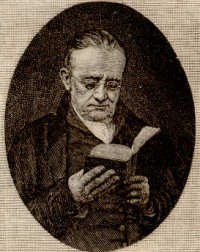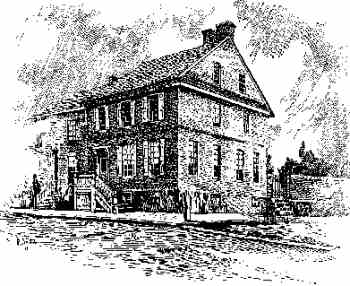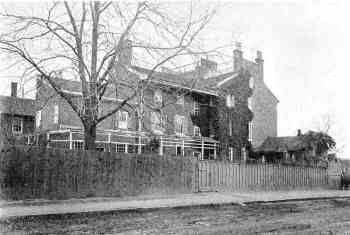Collecting Delaware Books
Delaware's First History
One of the rarest Delaware histories is A History of the Original Settlements on the Delaware by Benjamin Ferris, published in Wilmington by Wilson & Heald in 1846. Scharf, in his monumental 1888 history said the Ferris book was scarce at that time.
The scope of the book is indicated by the full title: A History of the Original Settlements on the Delaware from Its Discovery by Hudson to the Colonization Under William Penn. To Which is Added an Account of Ecclesiastical Affairs of the Swedish Settlers, and a History of Wilmington from Its First Settlement to the Present Time.
The Author

Benjamin Ferris was born in 1780 at Third and Shipley Streets in Wilmington. His ancestors had come from England in 1682, settling in Massachusetts and Connecticut. Four brothers, one of them Benjamin's grandfather, moved to Wilmington by 1748, making them among the earliest residents.
The family was Presbyterian in England, but soon switched to the Quaker faith. In later years, Benjamin debated religion with Presbyterian minister Eliphat Wheeler Gilbert in the press. The material was gathered into a book, The Letters of Paul and Amicus.
Ferris was said to be somewhat liberal in his faith, showing tolerance for both music and the lively spirits of young people. He did, however, abstain from voting in presidential elections because the president was commander in chief of the armed forces.
At 14 Ferris was apprenticed to a Philadelphia watchmaker. He kept himself fit by long early-morning walks before work. After work he read extensively and socialized with Huguenot immigrants, gaining a good knowledge of French, to his mother's chagrin.
After completing training, he worked as a watchmaker in Philadelphia. However, he gave up the profession and returned to Wilmington in 1813. He was appointed city surveyor and prepared real estate documents for others. This apparently gave him leisure for scholarly and charitable activities.
Ferris and other Quakers championed the cause of Seneca Indians in New York who had been defrauded by commercial land interests. Carrying the fight to the national level, they won a partial victory but not before permanent damage was done.
His scholarly activities centered around the history of Delaware and Wilmington. He paid a young Swede to teach him Swedish, so he could read the early records. Research took him to libraries in Pennsylvania and New York. Original sources and interviews of older residents added to his material. These studies, begun before 1830, resulted in his book published in 1846.
Ferris was also an early preservationist. He bitterly objected to the destruction of old buildings to build new and argued against quarrying on the Wilmington waterfront for material for the Delaware Breakwater. He complained when a maple tree dating to Dutch times was cut down and sold to a maker of rifle stocks.
A Pennsylvanian with Wilmington roots left a bequest to establish an institution to aid Delaware's free black citizens and named Benjamin Ferris as administrator. The heirs hired Delaware statesman John M. Clayton to break that provision of the will. In a jury trial, Clayton raised the specter of a black rebellion, because he had no other evidence or argument, and won the case. Though previously a close friend and supporter of Clayton, Ferris never forgave him and refused to speak to him again.
About 1856, Ferris was "seized by a paralysis," probably a stroke, and lost the ability to speak, read, or write. He never fuller recovered, though he took regular walks with family members. Ferris died November 9, 1867.
The Book
Measuring 5 by 9 inches, the 312-page book has three major parts. The first is the history of settlements on the Delaware, starting with the first near Gloucester, New Jersey, and the second at Lewes, Delaware. It ends 140 pages later with the establishment of William Penn's government in 1681. This material will be familiar to modern readers, but it was not readily available to early 19th century Delawareans.

N.W. corner of 3rd & Shipley.

N.W. corner of 3rd & West
The second part of the book consists of 48 pages of history of Old Swede's Church, starting with the church at Crane Hook.
The third part will be of most interest to modern readers. There are 118 pages of early Wilmington history. Land dealing, buildings, businesses, foreign trade, shipping, shipbuilding, the du Ponts, bridges, turnpikes, markets, railroads, steamboats, row houses, banking, water works, the town clock, prisons, and the yellow fever epidemics of 1798 and 1802 are just a few of the topics covered.
Ferris describes a series of three explosions at the powder works on the Brandywine in the spring of 1819. The third involved an underground storage magazine for finished product, said to have contained 30 tons of black powder. A rumor spread that a fourth explosion was imminent and would destroy the city. People fled Wilmington and stood in the fields waiting for the catastrophe that never came.
He also gives his version of the origin of the name Brandywine. The Swedes called the river Fish Kill. Early Wilmington tradition said the present name came from the accidental sinking of a Dutch ship with a cargo of brandy, called Brandy-wijn in Dutch, on the river's north shore, about 300 yards from its junction with the Christina. This happened shortly after 1655. Ferris quotes Frederick Craig, who died in 1841 at age 85, as saying older people pointed out the remains of the wreck when he was a child. Ferris claims that no other geographic feature had the Brandywine name attached to it until that time, lending credence to the tradition.
A History of the Original Settlements on the Delaware includes a number of excellent full-page illustrations including "Swede's Church in Wilmington," "Plan of Christina Fort," "A View of the Episcopal Church at New Castle," "Friends Old Meeting House, Wilmington," "First Presbyterian Meeting House, Wilmington," a map of "Willingtown now Wilmington," and a foldout map of Wilmington. These are on unnumbered leaves and appear to be tipped in. Buyers should make sure all are present.
There is some genealogical data in the book, especially on Swedish settlers. One interesting table gives common transformations of Dutch and Swedish names into English-sounding ones. For example Gostafsson is said to have become Justison or Justis.
So few copies of A History of the Original Settlements on the Delaware have come on the market in recent years that it is hard to establish a usual price. A copy in good condition and complete with all plates and maps often sells for about $100 More often, the binding has failed or plates are missing. The buyer will have to decide what it is worth.
Other Books by Benjamin Ferris
Ferris is listed as author or co-author of the following books. Most are quite rare and are best consulted in libraries, where some may be found on microfilm.
- Treaty with the Seneaca Indians. 1841. with the Society of Friends.
- A History of the Original Settlements on the Delaware. 1846.
- A History of the Original Settlements on the Delaware. reprinted 1987 with a genealogical index.
- Letters of Paul and Amicus. 1823. with Eliphat Wheeler Gilbert, 1783-1853.
- Observations on a Sermon delivered by John E. Latta at Newark … . 1823. pamphlet of 27 pages.
Plenty of information on Ferris is available in the standard histories and at local libraries and historical societies. A collection of articles by people who knew him is available as Papers of the Historical Society of Delaware No. xxxvii, Benjamin Ferris, published in 1903. Winterthur Library and Swarthmore College both have large collections of manuscript and other material indexed online. — JPR